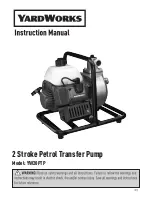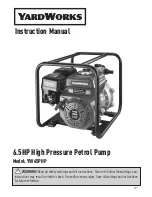
English (GB)
10
6. Fault finding
Warning
Before removing the terminal box cover, make sure that the power supply has been switched off. Make sure that it
cannot be accidentally switched on.
The pumped liquid may be scalding hot and under high pressure. Before any removal or dismantling of the pump,
the system must therefore be drained, or the isolating valves on either side of the pump must be closed.
Fault
Cause
Remedy
1. The pump does not run.
a) Supply failure.
Switch on the switch.
Check cables and cable connections for
defects and loose connections.
b) Fuses are blown.
Check cables and cable connections for
defects, and replace the fuses.
c) Motor protection tripped.
See 2. a), b), c), d), e), f).
d) Control-current circuit defective.
Repair or replace the control-current circuit.
2. Motor-protective circuit breaker has
tripped (trips out immediately when
supply is switched on).
a) Fuses are blown.
See 1. b).
b) Contacts of the motor-protective circuit
breaker or magnet coil defective.
Replace the contacts of the motor-protective
circuit breaker, the magnet coil or the entire
motor-protective circuit breaker.
c) Cable connection is loose or faulty.
Check cables and cable connections for
defects, and replace the fuses.
d) Motor winding is defective.
Repair or replace the motor.
e) Pump is mechanically blocked.
Switch off the power supply, and clean or
repair the pump.
f)
Setting of motor-protective circuit
breaker is too low.
Set the motor-protective circuit breaker
according to the rated current of the motor
(I
1/1
). See nameplate.
3. The motor-protective circuit breaker
trips out occasionally.
a) Setting of motor-protective circuit
breaker is too low.
See 2. f).
b) Periodic supply failure.
See 2. c).
c) Periodically low voltage.
Check cables and cable connections for
defects and loose connections.
Check that the supply cable of the pump is
correctly sized.
4. The motor-protective circuit breaker
has not tripped out, but the pump is
inadvertently out of operation.
a) See 1. a), b), d) and 2. e).
5. The pump performance is unstable.
a) Pump inlet pressure is too low.
Check the inlet conditions of the pump.
b) Suction pipe is partly blocked by
impurities.
Remove and clean the suction pipe.
c) Leakage in suction pipe.
Remove and repair the suction pipe.
d) Air in suction pipe or pump.
Vent the suction pipe/pump.
Check the inlet conditions of the pump.
6. The pump performance is unstable
and the pump is noisy.
Self-priming pumps only:
a) The differential pressure across the
pump is too low.
Close the tap gradually until the discharge
pressure is stable and the noise has ceased.
7. The pump runs, but gives no water.
a) Pump inlet pressure is too low.
See 5. a).
b) Suction pipe is partly clogged by
impurities.
See 5. b).
c) The foot or non-return valve is stuck in
its closed position.
Remove and clean, repair or replace the valve.
d) Leakage in suction pipe.
See 5. c).
e) Air in suction pipe or pump.
See 5. d).
8. When startup is attempted, the pump
will start, but delivers no pressure or
flow.
Self-priming pumps only:
a) Liquid column above non-return valve in
discharge pipe prevents the pump from
self-priming.
Empty the discharge pipe. Make sure that the
non-return valve does not hold back liquid in
the discharge pipe. Repeat the startup
procedure described in the installation and
operating instructions.
b) Suction pipe draws in air.
Make sure that the suction pipe is airtight from
pump to liquid level. Repeat the startup
procedure described in the installation and
operating instructions.


































